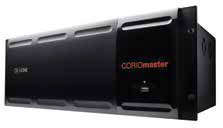Many people have seen video walls where the content appears soft, fuzzy, not very eye-catching. If this is the case when setting up a video wall, perhaps there is the problem of resolution mismatch. Consider the basic 2 x 2 video wall. If the source resolution is 1920 x 1080p, and each of the displays is also 1080p, then a single pixel is being stretched four times when it is output on the wall. If it is a bigger wall, then there will be more stretch and an even bigger distortion problem.
A good practice to follow is to have the highest resolution possible for the input source to the video wall. In the case of the 2 x 2 video wall with 1080p displays, a 4K source with a resolution of 3840 x 2160p would match pixels 1:1 with the displays, resulting in the crispest picture possible. Even on larger walls, a higher resolution input source would usually make a noticeable difference.
However, 4K is not always going to make a noticeable difference. “Many people think that if they have 4K input, they should also have 4K outputs for their video wall, however typically this isn’t true,” said Mark Armon, product manager at tvONE. Similar to the scenario above, this would also result in a soft or possibly jagged image, and require them to spend a lot more for this outcome. The 4K displays can’t make up pixel data, so the result is an image quality equal to or worse than with 1080p displays with a 2 x 2 video wall or larger. There is a time and a place for 4K displays in AV, for example in multi-viewer applications or close up and hands on experiences.
Another important factor when determining whether or not to use a 4K input is the viewing distance from the screen. As the distance increases between the viewer and the screen, a point is reached where the viewer’s eyes are not able to distinguish beyond a certain resolution. Integrators and installers might run these numbers prior to purchasing equipment, to determine what resolution is appropriate for a given system. The exact math equation requires complex square roots, exponents, and trigonometry, but rounding to the nearest inch simplifies things greatly (see sidebar to calculate the distance between the viewer and screen).
So, an 84-inch diagonal wall made up of 2 x 2 1080p displays using a 4K source would have a viewing distance of about 65 inches, or about 5.5 feet. If it were using a 1080p source, the viewing distance would be about 130 inches, or about 11 feet. What this means is that if the audience is standing more than 11 feet away from a video wall, their eyes can’t tell the difference between a 4K source and a 1080p source. With that in mind, viewing the same 1080p content at 5.5 feet they will definitely see the softness or jaggedness in the image, whereas they would not with a 4K source.
DIFFERENT SHAPES AND SIZES
Video walls can come in all shapes and sizes. If the video wall is going to consist of displays of various sizes, have non-standard bezels, or be mounted with a rotation, the designer might want to make sure the software used to control the wall makes it easy to compensate for this.
4K VIEWING DISTANCE CALCULATOR
To calculate the distance between the viewer and screen where a viewer can still see pixels, use this streamlined formula: Viewing Distance in inches ≈ Diagonal Screen Size in inches / (vertical resolution in pixels x .0006)
tvONE CORIOmaster Enhancements
The What: tvONE recently announced enhancements to its CORIOmaster video wall processing systems including: Live Video Window Transitions, Custom Resolutions, and 4K capabilities. CORIOmaster systems consists of two new modules; the HDMI 4K30/60 input module which allows resolutions of up to 3840x2160 and the HDMI 4K30 scaling output module, which allows for resolutions up to 3840x2160. Both modules are HDMI & HDCP 1.4 compatible. The CORIOmaster and CORIOmaster mini are cost effective and efficient tools for building videowall display arrays. These all-in-one system solutions can manage up to four canvases for supporting multiple video walls, while also performing various other video tasks simultaneously, including: real-time 360 video rotations, multi-image processing and rotation and edge blending.
The What Else: tvONE has invested tremendous resources creating CORIOgrapher, a software that makes it as easy for the end user to set up a video wall as setting up a PowerPoint presentation. tvONE is expected to release 4K input modules for its CORIOmaster video wall processer by early Q4 2015, available in HDMI and HDBaseT formats.
More Info:www.tvone.com
